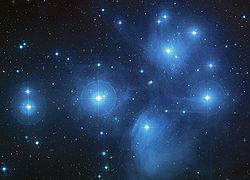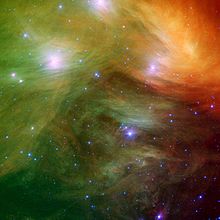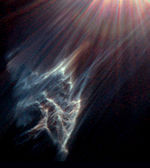- Pleiades
-
This article is about the star cluster. For other uses, see Pleiades (disambiguation).
Pleiades
Credit: NASA/ESA/AURA/Caltech
A color-composite image of the Pleiades from the Digitized Sky Survey.Observation data (J2000 epoch) Constellation Taurus Right ascension 3h 47m 24s[1] Declination +24° 7′[1] Distance 391–456 ly (120–140 pc[2][3][4][5]) Apparent magnitude (V) 1.6[6] Apparent dimensions (V) 110' (arcmin.)[6] Physical characteristics Other designations M45,[1] Seven Sisters,[1] Melotte 22[1] See also: Open cluster, List of open clusters In astronomy, the Pleiades, or Seven Sisters (Messier object 45), is an open star cluster containing middle-aged hot B-type stars located in the constellation of Taurus. It is among the nearest star clusters to Earth and is the cluster most obvious to the naked eye in the night sky. Pleiades has several meanings in different cultures and traditions.
The cluster is dominated by hot blue and extremely luminous stars that have formed within the last 100 million years. Dust that forms a faint reflection nebulosity around the brightest stars was thought at first to be left over from the formation of the cluster (hence the alternate name Maia Nebula after the star Maia), but is now known to be an unrelated dust cloud in the interstellar medium that the stars are currently passing through. Astronomers estimate that the cluster will survive for about another 250 million years, after which it will disperse due to gravitational interactions with its galactic neighborhood.
Contents
Observational history
 The Nebra sky disk, dated c. 1600 BC. The cluster of dots near the upper right portion of the disk is believed to be the Pleiades.
The Nebra sky disk, dated c. 1600 BC. The cluster of dots near the upper right portion of the disk is believed to be the Pleiades.
The Pleiades are a prominent sight in winter in the Northern Hemisphere and in summer in the Southern Hemisphere, and have been known since antiquity to cultures all around the world, including the Māori, Aboriginal Australians, the Persians, the Chinese, the Japanese, the Maya, the Aztec, and the Sioux and Cherokee. In Tamil culture this star is attributed to Lord Muruga (supposed to have been raised by 6 women), in Sanskrit he is noted as Skanda.
The Babylonian star catalogues name them MUL.MUL or "star of stars", and they head the list of stars along the ecliptic, reflecting the fact that they were close to the point of vernal equinox around the 23rd century BC. The earliest known depiction of the Pleiades is likely a bronze age artifact known as the Nebra sky disk, dated to approximately 1600 BC. Some Greek astronomers considered them to be a distinct constellation, and they are mentioned by Hesiod, and in Homer's Iliad and Odyssey. They are also mentioned three times in the Bible (Job 9:9 and 38:31, as well as Amos 5:8). The Pleiades (Krittika) are particularly revered in Hindu mythology as the six mothers of the war god Skanda, who developed six faces, one for each of them. Some scholars of Islam suggested that the Pleiades (Ats-tsuraiya) are the Star in Najm, which is mentioned in the Quran. The rising of the Pleiades on June 10 is mentioned in the Geoponica, which can be dated to 0:00:00 Universal Time June 10greg., 603 BC, viewed from the Kokino observatory, which was 800,000 days (without year zero) before the oldest biography of Nicolaus Copernicus was completed on October 7, 1588, by Bernardino Baldi.[7][8] The Greeks oriented the Hecatompedon temple of 1150 BC and the Parthenon of 438 BC to their rising.[9]
They have long been known to be a physically related group of stars rather than any chance alignment. The Reverend John Michell calculated in 1767 that the probability of a chance alignment of so many bright stars was only 1 in 500,000, and so correctly surmised that the Pleiades and many other clusters of stars must be physically related.[10] When studies were first made of the stars' proper motions, it was found that they are all moving in the same direction across the sky, at the same rate, further demonstrating that they were related.
Charles Messier measured the position of the cluster and included it as M45 in his catalogue of comet-like objects, published in 1771. Along with the Orion Nebula and the Praesepe cluster, Messier's inclusion of the Pleiades has been noted as curious, as most of Messier's objects were much fainter and more easily confused with comets—something that seems scarcely possible for the Pleiades. One possibility is that Messier simply wanted to have a larger catalogue than his scientific rival Lacaille, whose 1755 catalogue contained 42 objects, and so he added some bright, well-known objects to boost his list.[11]
Distance
 Comet Machholz appears to pass near the Pleiades in early 2005
Comet Machholz appears to pass near the Pleiades in early 2005
The distance to the Pleiades has elicited much controversy, namely since the cluster is an important first step in the cosmic distance ladder, which lays the foundation for the astronomical distance scale. The size of this first step calibrates the whole ladder, and the scale of this first step has been estimated by many methods. As the cluster is so close to the Earth, its distance is relatively easy to measure. Accurate knowledge of the distance allows astronomers to plot a Hertzsprung-Russell diagram for the cluster, which, when compared to those plotted for clusters whose distance is not known, allows their distances to be estimated. Other methods can then extend the distance scale from open clusters to galaxies and clusters of galaxies, and a cosmic distance ladder can be constructed. Ultimately astronomers' understanding of the age and future evolution of the universe is influenced by their knowledge of the distance to the Pleiades.
Results prior to the launch of the Hipparcos satellite generally found that the Pleiades were about 135 parsecs away from Earth. Data from Hipparcos yielded a surprising result, namely a distance of only 118 parsecs by measuring the parallax of stars in the cluster—a technique that should yield the most direct and accurate results. Later work consistently argued that the Hipparcos distance measurement for the Pleiades was erroneous.[4][4][5][12][13] In particular, distances derived to the cluster via the Hubble Space Telescope and infrared color-magnitude diagram fitting favor a distance between 135–140 pc.[3][12] However, the author of the 2009 catalog of revised Hipparcos parallaxes reasserted that the distance to the Pleiades is ~120 pc, and reviewed the dissenting evidence.[2] Some authors argue that the controversy over the distance to the Pleiades is a red herring, since the cosmic distance ladder can (presently) rely on a suite of other nearby clusters where consensus exists regarding the distances as established by Hipparcos and independent means (e.g., the Hyades, Coma Ber, etc.).[3]
Composition
 X-ray images of the Pleiades reveal the stars with the hottest atmospheres. Green squares indicate the seven optically brightest stars.
X-ray images of the Pleiades reveal the stars with the hottest atmospheres. Green squares indicate the seven optically brightest stars.
The cluster core radius is about 8 light years and tidal radius is about 43 light years. The cluster contains over 1,000 statistically confirmed members, although this figure excludes unresolved binary stars.[14] It is dominated by young, hot blue stars, up to 14 of which can be seen with the naked eye depending on local observing conditions. The arrangement of the brightest stars is somewhat similar to Ursa Major and Ursa Minor. The total mass contained in the cluster is estimated to be about 800 solar masses.[14]
The cluster contains many brown dwarfs, which are objects with less than about 8% of the Sun's mass, not heavy enough for nuclear fusion reactions to start in their cores and become proper stars. They may constitute up to 25% of the total population of the cluster, although they contribute less than 2% of the total mass.[15] Astronomers have made great efforts to find and analyse brown dwarfs in the Pleiades and other young clusters, because they are still relatively bright and observable, while brown dwarfs in older clusters have faded and are much more difficult to study.
Age and future evolution
Ages for star clusters can be estimated by comparing the Hertzsprung-Russell diagram for the cluster with theoretical models of stellar evolution, and using this technique, ages for the Pleiades of between 75 and 150 million years have been estimated. The spread in estimated ages is a result of uncertainties in stellar evolution models. In particular, models including a phenomenon known as convective overshoot, in which a convective zone within a star penetrates an otherwise non-convective zone, resulting in higher apparent ages.
Another way of estimating the age of the cluster is by looking at the lowest-mass objects. In normal main sequence stars, lithium is rapidly destroyed in nuclear fusion reactions, but brown dwarfs can retain their lithium. Due to lithium's very low ignition temperature of 2.5 million kelvin, the highest-mass brown dwarfs will burn it eventually, and so determining the highest mass of brown dwarfs still containing lithium in the cluster can give an idea of its age. Applying this technique to the Pleiades gives an age of about 115 million years.[16][17]
The cluster's relative motion will eventually lead it to be located, as seen from Earth many millennia in the future, passing below the feet of what is currently the constellation of Orion. Also, like most open clusters, the Pleiades will not stay gravitationally bound forever, as some component stars will be ejected after close encounters and others will be stripped by tidal gravitational fields. Calculations suggest that the cluster will take about 250 million years to disperse, with gravitational interactions with giant molecular clouds and the spiral arms of our galaxy also hastening its demise.
Reflection nebulosity
Under ideal observing conditions, some hint of nebulosity may be seen around the cluster, and this shows up in long-exposure photographs. It is a reflection nebula, caused by dust reflecting the blue light of the hot, young stars.
It was formerly thought that the dust was left over from the formation of the cluster, but at the age of about 100 million years generally accepted for the cluster, almost all the dust originally present would have been dispersed by radiation pressure. Instead, it seems that the cluster is simply passing through a particularly dusty region of the interstellar medium.
Studies show that the dust responsible for the nebulosity is not uniformly distributed, but is concentrated mainly in two layers along the line of sight to the cluster. These layers may have been formed by deceleration due to radiation pressure as the dust has moved towards the stars.[18]
Brightest stars in Pleiades
The nine brightest stars of the Pleiades are named for the Seven Sisters of Greek mythology: Sterope, Merope, Electra, Maia, Taygeta, Celaeno, and Alcyone, along with their parents Atlas and Pleione. As daughters of Atlas, the Hyades were sisters of the Pleiades. The English name of the cluster itself is of Greek origin, though of uncertain etymology. Suggested derivations include: from πλεîν pleîn, to sail, making the Pleiades the "sailing ones"; from pleos, full or many; or from peleiades, flock of doves. The following table gives details of the brightest stars in the cluster:
Pleiades Bright Stars Name Pronunciation (IPA & respelling) Designation Apparent magnitude Stellar classification Alcyone /ælˈsaɪ.əniː/ al-sy-ə-nee Eta (25) Tauri 2.86 B7IIIe Atlas /ˈætləs/ at-ləs 27 Tauri 3.62 B8III Electra / ɪˈlɛktrə/ i-lek-trə17 Tauri 3.70 B6IIIe Maia /ˈmeɪə, ˈmaɪə/ may-ə, my-ə 20 Tauri 3.86 B7III Merope /ˈmɛrəpiː/ merr-ə-pee 23 Tauri 4.17 B6IVev Taygeta /teɪˈɪdʒ ɪtə/ tay-ij-i-tə19 Tauri 4.29 B6V Pleione /ˈplaɪ.əniː/ ply-ə-nee 28 (BU) Tauri 5.09 (var.) B8IVpe Celaeno /s ɪˈliːnoʊ/ sə-lee-noh16 Tauri 5.44 B7IV Sterope, Asterope /ˈstɛrɵpiː, əˈstɛrɵpiː/ (ə)-sterr-ə-pee 21 and 22 Tauri 5.64;6.41 B8Ve/B9V — — 18 Tauri 5.65 B8V Cultural significance
Main article: Pleiades in folklore and literature- Japanese automaker Subaru derives its name from the cluster, which is represented by six stars in its corporate logo.[19]
- The satellite phone company Thuraya is named after the Arabic word for the Pleiades*
- Mentioned in the song "Can't Stop" by the Red Hot Chili Peppers
- Randall the creator of the webcomic xkcd has chosen this celestial object as his favorite.[20]
Names and pronunciation
The English pronunciation of the name Pleiades depends on the speaker.
- US: /ˈpliː.ədiːz/ plee-ə-deez or sometimes /ˈpleɪ.ədiːz/ play-ə-deez
- UK: /ˈplaɪ.ədiːz/ ply-ə-deez
- Canadian English: /ˈpleɪ.ədiːz/ play-ə-deez
See also
- List of Messier objects
- List of open clusters
- New General Catalogue
References
- ^ a b c d e "SIMBAD Astronomical Database". Results for M45. http://simbad.u-strasbg.fr/Simbad. Retrieved 2007-04-20.
- ^ a b van Leeuwen, F. "Parallaxes and proper motions for 20 open clusters as based on the new Hipparcos catalogue", A\&A, 2009
- ^ a b c Majaess, D.; Turner, D.; Lane, D.; Krajci, T. "Deep Infrared ZAMS Fits to Benchmark Open Clusters Hosting delta Scuti Stars", JAAVSO, 2011
- ^ a b c Percival, S. M.; Salaris, M.; Groenewegen, M. A. T. (2005). "The distance to the Pleiades. Main sequence fitting in the near infrared". Astronomy and Astrophysics 429: 887. arXiv:astro-ph/0409362. Bibcode 2005A&A...429..887P. doi:10.1051/0004-6361:20041694.
- ^ a b Zwahlen, N.; North, P.; Debernardi, Y.; Eyer, L.; Galland, F.; Groenewegen, M. A. T.; Hummel, C. A. (2004). "A purely geometric distance to the binary star Atlas, a member of the Pleiades". Astronomy and Astrophysics Letters 425: L45. arXiv:astro-ph/0408430. Bibcode 2004A&A...425L..45Z. doi:10.1051/0004-6361:200400062.
- ^ a b Messier 45
- ^ http://www.ancientlibrary.com/geoponica/0028.html
- ^ On the revolutions, Foundations of natural history, Band 1, p. 335, Nicolaus Copernicus: Complete Works, Edward Rosen, Johns Hopkins University Press, 1992.
- ^ On the Rising of the Pleiades
- ^ Michell J. (1767). "An Inquiry into the probable Parallax, and Magnitude, of the Fixed Stars, from the Quantity of Light which they afford us, and the particular Circumstances of their Situation". Philosophical Transactions 57: 234–264. Bibcode 1767RSPT...57..234M. doi:10.1098/rstl.1767.0028.
- ^ Frommert, Hartmut (1998). "Messier Questions & Answers". http://www.seds.org/messier/m-q&a.html#why_M42-45. Retrieved 2005-03-01.
- ^ a b Soderblom D. R., Nelan E., Benedict G. F., McArthur B., Ramirez I., Spiesman W., Jones B. F. (2005). "Confirmation of Errors in Hipparcos Parallaxes from Hubble Space Telescope Fine Guidance Sensor Astrometry of the Pleiades". Astronomical Journal 129: 1616–1624. arXiv:astro-ph/0412093. Bibcode 2005AJ....129.1616S. doi:10.1086/427860.
- ^ Turner, D. G. (1979). "A reddening-free main sequence for the Pleiades cluster". Publications of the Astronomical Society of the Pacific 91: 642–647. Bibcode 1979PASP...91..642T. doi:10.1086/130556.
- ^ a b Adams, Joseph D.; Stauffer, John R.; Monet, David G.; Skrutskie, Michael F.; Beichman, Charles A. (2001). "The Mass and Structure of the Pleiades Star Cluster from 2MASS". Astronomical Journal 121: 2053. arXiv:astro-ph/0101139. Bibcode 2001AJ....121.2053A. doi:10.1086/319965.
- ^ Moraux, E.; Bouvier, J.; Stauffer, J. R.; Cuillandre, J.-C. (2003). "Brown in the Pleiades cluster: Clues to the substellar mass function". Astronomy and Astrophysics 400: 891. arXiv:astro-ph/0212571. Bibcode 2003A&A...400..891M. doi:10.1051/0004-6361:20021903.
- ^ Basri G., Marcy G. W., Graham J. R. (1996). "Lithium in Brown Dwarf Candidates: The Mass and Age of the Faintest Pleiades Stars". Astrophysical Journal 458: 600. Bibcode 1996ApJ...458..600B. doi:10.1086/176842.
- ^ Ushomirsky, G., Matzner, C., Brown, E., Bildsten, L., Hilliard, V., Schroeder, P. (1998). "Light-Element Depletion in Contracting Brown Dwarfs and Pre-Main-Sequence Stars". Astrophysical Journal 497: 253. arXiv:astro-ph/9711099. Bibcode 1998ApJ...497..253U. doi:10.1086/305457.
- ^ Gibson, Steven J.; Nordsieck, Kenneth H. (2003). "The Pleiades Reflection Nebula. II. Simple Model Constraints on Dust Properties and Scattering Geometry". Astrophysical Journal 589: 362. Bibcode 2003ApJ...589..362G. doi:10.1086/374590.
- ^ Kim, Chang-Ran (November 27, 2009). "FACTBOX-Five facts about Subaru-maker Fuji Heavy Industries". Reuters. http://www.reuters.com/article/marketsNews/idUST32250720091127.
- ^ "xkcd.com/about". http://www.xkcd.com/about/.
External links
- The Pleiades (M45) At the astro-photography site of Mr. T. Yoshida.
- Photos and information on the Pleiades from the University of Calgary
- Information on the Pleiades from SEDS
- Information and images from the Anglo-Australian Observatory
- WEBDA open cluster database webpage on Pleiades cluster – E. Pauzen (Univ. Vienna)
- NightSkyInfo.com: The Pleiades
- Maya Astronomy
- Doppler Imaging: Results first Doppler image of a Pleiades solar-type G dwarf – HII314, Strassmeier & Rice 2001, A&A 377, 264
- Dark Atmospheres Photography (deep nebulosity exposure)
- Pleiades in Hungarian and Middle Asian culture
- The Pleiades on WikiSky: DSS2, SDSS, GALEX, IRAS, Hydrogen α, X-Ray, Astrophoto, Sky Map, Articles and images
Messier objects List M1 · M2 · M3 · M4 · M5 · M6 · M7 · M8 · M9 · M10 · M11 · M12 · M13 · M14 · M15 · M16 · M17 · M18 · M19 · M20 · M21 · M22 · M23 · M24 · M25 · M26 · M27 · M28 · M29 · M30 · M31 · M32 · M33 · M34 · M35 · M36 · M37 · M38 · M39 · M40 · M41 · M42 · M43 · M44 · M45 · M46 · M47 · M48 · M49 · M50 · M51 · M52 · M53 · M54 · M55 · M56 · M57 · M58 · M59 · M60 · M61 · M62 · M63 · M64 · M65 · M66 · M67 · M68 · M69 · M70 · M71 · M72 · M73 · M74 · M75 · M76 · M77 · M78 · M79 · M80 · M81 · M82 · M83 · M84 · M85 · M86 · M87 · M88 · M89 · M90 · M91 · M92 · M93 · M94 · M95 · M96 · M97 · M98 · M99 · M100 · M101 · M102 · M103 · M104 · M105 · M106 · M107 · M108 · M109 · M110See also  Book:Messier objects ·
Book:Messier objects ·  Category:Messier objects
Category:Messier objects  Portal:AstronomyCategories:
Portal:AstronomyCategories:- Messier objects
- NGC objects
- Open clusters
- Pleiades Open Cluster
- Taurus constellation
- Orion arm
- UFO-related locations
Wikimedia Foundation. 2010.




